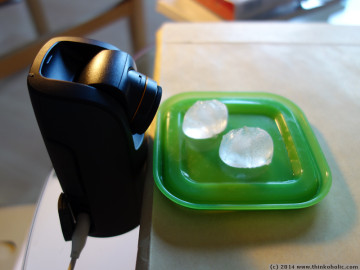 in a recent blog post, i detailled the results of my search for a viable construction time lapse camera. the short version: the TLC200 Pro by Brinno sounded like the best option considering viewing angle, long-term usability and pricing.
in a recent blog post, i detailled the results of my search for a viable construction time lapse camera. the short version: the TLC200 Pro by Brinno sounded like the best option considering viewing angle, long-term usability and pricing.
the camera and some accessories were delivered recently, and i found the answers to some of my original questions. in this article, you’ll find a short review and my initial experience with brinno’s “pro” time lapse camera.
box contents:
- Brinno TLC200 Pro
- 4 AA batteries (Toshiba alkaline)
- 1 4GB SD-Card (Imation, class 4)
- printed manual booklet and quick start guide
- 2 lens covers, shallow and deep
- 1 focus fixation screw (slotted)
- tiny screwdriver (cross)
for future outdoor use, my order also included the ATH120 weather resistant housing and AWM100 wall mount.
first steps
the current firmware (v1.01.5) was already preinstalled, so no firmware update was necessary. navigation through the menu is pretty straight-forward using the three buttons (“Menu”, “Time”, “OK”). the camera’s standard settings were medium image quality (“better”) and 10 fps video frame rate – you might want to change the latter one to a higher frame-rate to get more fluid movements. if you forget, there are tools to change the frame-rate without image quality loss (see “test videos”).
there are three image quality settings (see manual, page 23):
good: 70-150 KB per frame
better: 150-300 KB per frame
best: 200-400 KB per frame
the camera itself takes SD cards up to 32 GB in capacity, so there’s potential space for about 240.000 frames (“good” quality) or roughly 100.000 frames at “best” quality. however, the manual (page 16) mentions that avi files are “limited to between 8.192 and 20.480 frames, depending on the time interval setting”, which is probably in reference to the file size limit of 4 GB for fat32 formatted sd cards (and completely unrelated to the actual interval setting).
in other words, it’s important to keep in mind that cards bigger than 4 GB don’t make sense for one continuous video!
- update 2014-04-27: reader adwheeler (see comment below) says that files are closed when they reach 4 GB, but recording continues into a new file that can later be appended to the first file.
two side notes regarding the housing and wall mount:
- when using the weather resistant housing (ATH120) with external power supply, be sure to also order the fitting micro-usb cable from brinno, which will seal into the square rubber opening on the side of the housing!
- despite its considerable price point, the AWM100 wall mount is only made from black plastic and feels a bit light/flexible/breakable. it comes with screws and anchor bolts, both of which i decided to replace with higher-profile parts.
specific questions
will the “Timer” feature activate just once, or daily?
unfortunately, the timer will only activate once. it can be set to run through the night (i.e. 22:00 – 04:00), but when the end time is reached, the camera closes the avi-file and returns to power saving mode. it will not start again without manual re-activation, i.e. pressing the “OK” button when in the home screen (see update below).i also tried interrupting external power as a workaround, to force a camera restart. this didn’t work, since the camera requires the activation via the hardware “OK” button.
- update: according several comments to this post (see below), the timer activates daily, but creates separate files for each day that you’ll need to merge afterwards.
does external power also charge the batteries?
unfortunately, no. the camera restarts when being connected to external power, i.e. it loses power for an instant while changing power source. Rechargeable batteries are not being recharged when running on external power.
when are Eye-Fi files uploaded/available?
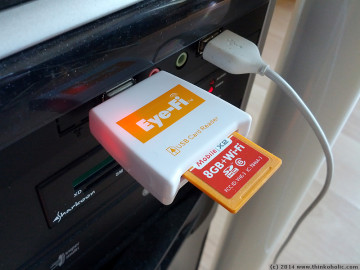 my hopes were high that an Eye-Fi card would allow me to upload a daily version of what’s been recorded so far. while this is possible using the timer function (which creates separate, daily files), in a continuous recording the avi-file is completed only at the very end of the recording, and Eye-Fi will only upload completed files.
my hopes were high that an Eye-Fi card would allow me to upload a daily version of what’s been recorded so far. while this is possible using the timer function (which creates separate, daily files), in a continuous recording the avi-file is completed only at the very end of the recording, and Eye-Fi will only upload completed files.
with Eye-Fi’s handy (optional) upload notification emails, it may also be handy to use an Eye-Fi card so you’ll be notified when the camera has stopped recording. unfortunately, i didn’t get around to testing whether this also works when the camera crashes or reboots unexpectedly (e.g. during a power outage when on external power).
is the camera really compatible with Eye-Fi?
while testing the camera and card for a short few days, i noticed the camera frequently froze at the “Reading SD Card” screen when booting with the Eye-Fi card (Eye-Fi Mobile X2 8GB+WiFi) installed. removing and re-inserting the card always solved the problem, but it’s not nice to have this happen, especially in the field.
there was no more time for more testing and troubleshooting this problem, so i can’t say whether this was caused by the card or the camera, but it never happened with the standard 4 GB card.
- update 2014-04-27: adwheeler (comment below) says he has not encountered such problems with an Eye-Fi pro x2 card. if you’ve used an Eye-Fi card with your Brinno TLC200 pro, please share your experiences in the comments section!
test videos
video #1
for the first TLC200 Pro test video, i just set the camera to an interval of 2 seconds and “best” image quality. the low default video frame rate (10 fps) was later changed to 30 fps using avifrate (no change to image data). basic setup was really easy, even without reading the manual.
as you can see, the image quality is generally quite nice. the light hickup in white-balance is probably due to the direct sunlight. reflections result from indoor use about 5 cm from the window. part of the middle tree is blurry due to a dirt speck on the window.
the video consists of 1740 frames and weighs in at 382,971 KB, so a single frame is about 220 KB. the official rating for “best” quality frames is 200-400 KB.
video #2: TLC200 Pro vs. Hero3 Black
next up, here’s a comparison of a Brinno TLC200 Pro and GoPro Hero3 Black.
brinno settings: 2 sec interval, image quality best, 30 fps, using external power.
gopro settings: 2 sec interval, 12 MP resolution, Protune off. the full-hd video was created using GoPro Studio, with no changes to image data except for resizing.
the comparison shows the strengths of both systems: the TLC200 Pro does everything by itself, no post-processing required. image quality is not bad, but it is, after all, only a 720p video (1280×720). the optional time stamp at the bottom of the video is a nice touch, especially for longer-term recordings.
also, the camera’s four AA batteries should last quite some time, especially with the camera going to power save mode in between pictures. the camera ran on external power during this test, so i don’t have specific numbers.
in contrast, the Hero3 Black’s image quality and resolution is simply stunning, and the resulting full-hd (or bigger) videos are just beautiful. as a downside, the minimum resolution of 5 megapixels means that you’ll need a big sd-card. also, intervals are limited to 60 s max, and the camera gave its first “low battery” warning after 55 minutes (wifi on, outside setting at 5-10°C), so storage capacity is probably not be the primary limiting factor here.
video #3: close focus
the next video is an image quality test at close focus. the closer of the two ice cubes was about 4 cm from the lens, a cheap fluorescent lamp to the left, about 70 cm behind the setup, was used for lighting.
interval and duration: 1 s for 2 hours (later sped up 4x using avifrate).
the camera did a great job at close focus, and the f/2.0 lens created a nicely blurred background.
the TLC200 Pro is now installed semi-outdoor to document a construction project, and i’m very eager to see the outcome.
if you have any remarks or questions, don’t hesitate to post a comment!
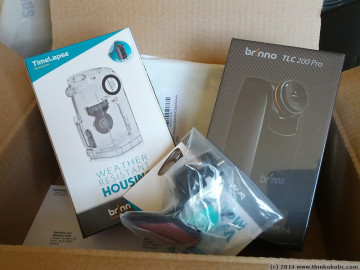
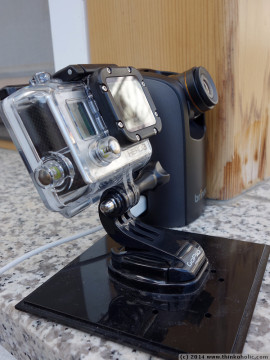
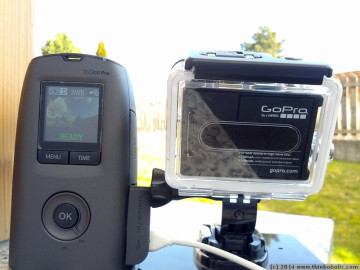
Hi,
thanks for your really informative post on the TLC200. I am planning to use a TLC200 to make a film of mushrooms growing. I estimate the whole process will take 48 days and i want to take a frame every 80 seconds using Best quality. I’m confused about the implications of the maximum 20,480/4GB file size. Do you know what happens when the AVI file gets to this size – does the camera stop recording, and then restart, or do you have to manually restart the recording?
Thanks, Jane
hi jane,
i haven’t tested this specific case, but from the rest of the user experience i’d bet that recording just stops when the file size reaches 4 GB, and you’ll have to restart recording manually.
if you do try this yourself before you start your actual recording, please share your findings here! :)
HI Markus,
I’ve been told by a photographer that the Brinno will restart recording automatically. I’ll let you know if this actually happens!
Jane
now that would be very welcome news! please do keep us posted!
Okay, well you are wrong in this review in many counts. The timer function will continually record every day at the set time until you turn the camera off by holding the OK button. Also, your statement that cards bigger than 4gig don’t make sense is false. When the .AVI file reaches 4 gigs it will close that file and start a new one and so on until the card is full. All you need to do is stitch the files together with an editing program. Hope this clears up everyone’s questions. You might want to thoroughly test the item before writing a review such as this one. You might want to re-flash your firmware as I have had no such problems with my eye-fi pro x2 card and the TLC200 Pro HDR.
thanks for your corrections – I’ll update the article.
true, i only had a few days before the camera needed to be in place and ready. in my test with the timer function, though, i’m pretty sure the camera only recorded one day and then stopped.
Hello, I am planning to buy Brinno TLC 200 pro for monitoring in remote area.
After I read the review above… I need more confirmation on some areas…
First, since the camera will be put in remote area, I need to change the SD Card around every 3 days. So, during that time interval, will the camera require no human intervention? I will be using timer.
Second, how about the night view? Is it good?
Third, since I am planning to have motion detector and setting timer. I am wondering if the camera is off, and there is a motion, will the camera start taking shots again?
Thank you very much
hi yan lin,
1. in a very quick first test, i was under the impression that the camera stops recording after the first timer run. adwheeler has pointed out in the comments that the camera will keep recording within the specified timespan, when the timer is set. i can’t confirm this, though, since my camera is currently in use somewhere else.
2. in my own recordings so far, the camera was set to sleep when it gets too dark. there are modes for night sky and moon, though, and the few sample videos available on youtube are quite impressive.
3. no idea, sorry. if you do test this, can you please let us know your results?
Has anyone had any luck playing the files via Eye-Fi on an iPhone4S? I get a file not supported error. Any work arounds?
I have been using the timer function on my Brinno TLC200 Pro. The camera has continually recorded every day as noted by AdWheeler, however when plugging the SD card into my computer I saw that each day had been saved as a different file. Is there a way to use the timer function and only create one file so the files do not have to be manually combined afterwards? Any thoughts or help appreciated!
I can agree with adwheeler the timer function will work as long as you stop the recording manually by pressing and holding the OK button.
With the Eye-Fi cards you should certainly think about bigger than 4GB cards as the files get big fast when using a shorter intervals and in ASAP mode even a 8GB card can’t upload a file fast enough to make room for new files.
In timer mode a AVI file is created when the recording starts and frames are added till the end of timer time, new day will start with a new file, so the previous file can be easily uploaded to the FTP.
When using a Eye-Fi cards you should always use a external power source as the batteries with Eye-Fi can run out with hours.
Hi! I am planning to buy some Brinno camera to monitor my home while I am away nut I would like to wacth the video right away when I come back home and I may not have access to computer. It says in Brinno home page that videos can be watched in Android phone but I am not sure how this works. What kind of phone I should buy? Has anybody tried this?
hi sh,
android phones can play the file format, but you still need to transfer the files to your phone. you could use a simple “usb on the go” (OTG) card reader if your phone supports it, otherwise setting up an EyeFi wifi-enabled sd-card might actually be the easiest way (no special phone requirements).
Thank you Markus.
Is there a way to watch eye fi recordings on an iPhone?
I’m trying to set my brinno up for a year long construction project. It will have an external power source but will be at a height inconvenient to keep changing the card. I was hoping eye fi would allow me to remotely capture the images. Thanks
I have a problem with Brinno BCC100 and Eye-fi / Toshiba Flash Air.
I try to read the video by wifi, download and erase them.
Open the wifi after hours of capturing is difficult or not possible, someone know if there are some steps to do this.
Erase the video is not possible, someone know hoe to manage this.
The objective is don’t touch the camera for long time recording in construction enviroments and don’t lose the frame.
Thanks to all
Can I view the photos captured remotely? I have a Brinno TLC at a job site and want to view the captured photos remotely. There is WiFi access via a Hotspot at the job site. So, could I put a EyeFi in the Brinno, connect it to the Hotspot at the job site and access remotely (not on the WiFi network). Please help and thank you!
Alex, maybe you could set the “Endless Memory Mode” to erase old videos.
http://notebooks.com/2011/03/10/eye-fi-5-tips-and-tricks-for-getting-the-most-out-of-eye-fi-sd-cards/
Hi Markus, I just purchased the EyeFI mobi PRO to use wuth my Brinno TLC 200 Pro but Im unable to get a reliable connection (PC to EyeFI card) It did it once and I downloaded one image but thats it. ?
Hi Chris, I ended up not keeping my EyeFi card and doing manual downloads instead, so I can’t really help you there. A pointer though: The card requires camera power. Could it be that the camera’s low-power “standby” mode interferes here when running on batteries? Maybe try connecting after pressing any button on the camera to wake it up.
Hi! Does anyone knows how to re-flash the firmware as Adwheeler mentioned? Thanks!
Actually, we can buy the TLC200 Pro for about 200 EUR. For the same price you get the BCC100 including the weather resisting case, the wall-mount and some kind of rubber strap to fix the device. Does someone know if the lens with 1.3MB from the TLC200Pro produces much better pictures (with same 1280 x 720 Pixels resolution) then the BCC100? I mean, to produce a time lapse video about the neighbours house construction is it worth to spend more money for the TCL200 Pro?
I would check out some time lapse videos from both cameras on youtube. That should give you a good idea of any quality differences.